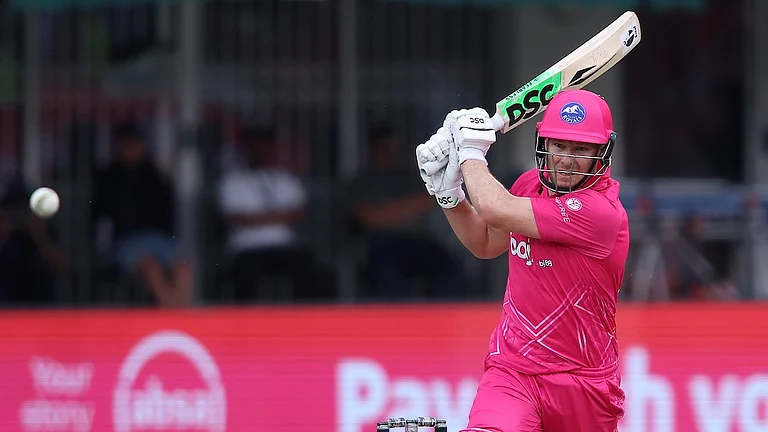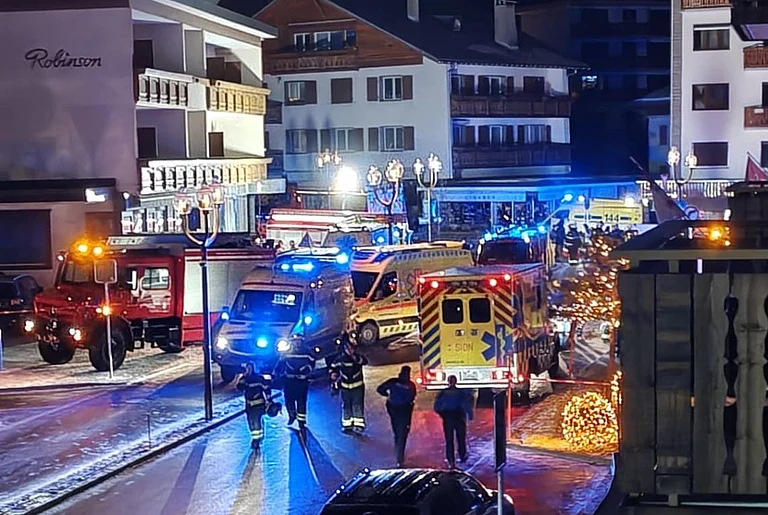After two works of fiction Mehta returns to that sardonic form by layering acid polemic with the cool sophistication of belles-letters. "These essays are an attempt to explain something of modern India to myself," she writes. That explanation cannot be complete without an attempt to explain its politics. As the daughter of a leading politician she has observed many of the developments upf-ront (starting with a five-year-old's jerky recall of Gandhi's funeral) and although she has lived in and out of India for much of her adult life, staying away has sharpened the view. Looking back over 50 years, Mehta observes that "the most interesting evolution in independent India is the change from individual fearlessness...to craven courting of those who possess social and political power."
The Nehru-Gandhis naturally come in for a spirited debunking. Mehta charts the decline of dissent and "the beginning of a terrible nepotism" as Indira's India is transformed "from a democracy to a court." Of her Cambridge contemporary Rajiv Gandhi, she is equally acerbic: "American Presidents jog. So the Prime Minister of India instructs his cabinet to get into jogging suits....In living colour, we were entering the age of disco democracy." But it is in trying to trace larger patterns—recurring violence in a country committed to non-violence, its splintering society and skewed economics—that Mehta's canvas comes alive and she finds her voice.
The essays do not follow a chronology or even a theme but are arranged as a film montage, adhering to the cinematic conventions of flashback, panoramic view or tight close-up. The most memorable pieces have little to do with politics or history. By taking a hand-held camera into an Indian home, or turning it upon herself, her ruminations on why literate Indians have such eclectic reading or home-decorating habits are hilarious. Like a good director she both exaggerates and simplifies the facts and skilfully modulates the tone from outrage to calm reflection by throwing in a good many jokes to keep the pot bubbling. It is Mehta up to vintage mischief again.
And my own lecture on the Westerners who had given up their expensive toys in the hope of acquiring India's fabled spiritual depth, while Indians traded anything they had, including spiritual depth, for the chance of owning those discarded toys—was it an illustration of such crisis?
By the time the conference was to begin the Prime Minister of India, our Foreign Secretary, our top advisers on Planning and Administrative reforms were all on the agenda. A weight lifted from my shoulders. If they couldn't convince the entrepreneurs of the world to invest in India, who could? Unless the way to a president's heart was through his stomach, in which case we had as back-up the five primary sauces of India, to be demonstrated in a lecture on The Colourful World of Indian Cuisine: Brown, Red, Yellow, White and Green.
And then the 500 presidents and their wives were in town, snarling up the traffic, hogging the hotel rooms. Business as usual.
Not so usual were the side-shows in the hotel foyers in homage to the one essential required for inclusion in the Young Presidents' Association—Big Bucks. Jewellers bent over gems, peering through the loupes fixed to their eyes. Vendors who had come all the way form Benares smiled politely as they tried to slide fragile glass bangles over wrists larger than any they had ever seen. Veiled women from Rajasthan leaned over copper bowls filled with henna paste to paint elaborate fertility designs on the palms of queueing wives. Sometimes the ladies were joined by the Young Presidents themselves, but no one laughed during the conference when men proffered hands covered with female fertility designs. After all, the rich are supposed to be different.
Actually what identified these rich was their sheer stamina. From dawn jogging and yoga classes via a quick swim and a set of tennis, they raced off to learn how to tie saris and turbans, drove a hundred miles to Agra to see the Taj Mahal, bought carpets, were received for tea by a real president—the President of India—watched polo matches played by the Sixty-First Cavalry Regiment, visited outlying factories and villages, dined in different houses to see how real Indians lived, shopped ceaselessly, and still managed to attend the lectures taking place throughout the day. And they were only in town for a week.
The crisp voices from New York, in person belonging to people more Cosmopolitan than Third Reich, remained maddeningly unflappable as they orchestrated solutions to all this busy work and other India '86 problems. I complained that now I was following not only Mother Teresa but the Prime Minister as well. What kind of billing was that? They clucked sympathetically, didn't change a thing, and gave me a sandalwood medallion engraved with my name and designation—Faculty—and a cloth satchel filled with that glossy paper that sticks to your fingers. More crimson brochures which listed the best eating and shopping in India, proliferating proof of the 20th century's drive to consume.
At least that's what Mother Teresa implied in her shockingly contemporary appeal. She wanted help for victims of AIDS. The Young Presidents had already agreed to ante-up a million tax-deductible dollars for her hospices in New York. Now she was telling them their money wasn't good enough. She wanted their personal participation.... The haze of sentimentality evaporated instantly. No one was prepared to extend a hennaed hand in lieu of a cheque book. Easier to accommodate was her request that they be humane to their employees—enquire about their children's names.
Wiping tears of emotion from their eyes as Mother Teresa ended her address the Eds, Bobs, Als, Chucks, married to the Babses, Frans, Connies, Sues, settled back in their chairs to listen to the next speaker—a man who could have been one of their own.
Head of a country by the age of 40, it was the open-minded Prime Minister of India telling them how he wanted to take his unwieldy corporation into the 21st century. Just as Mother Teresa was the acceptable face of charity, so Rajiv Gandhi was the acceptable face of Third World leadership.
THEN he had left everyone filled in their evaluation forms. There were six categories and eight sub-categories by which all speakers—saints, Prime Ministers, geo-political experts—were to be judged. One was the lowest rating, 10 the highest. Rajiv Gandhi only made Sixes and Sevens. Mother Teresa was a straight and unanimous 10. After all, she was a star.
And stars are for consumers. As Mother Teresa tried to make her get-away she was hauled out of her van by millionaires pleading to be photographed with her. Looking like an irritated ET in her white sari with its blue border she reluctantly dismounted from her van again and again. But she was consoled when she heard her score. 'I'm a 10! I'm a 10!' she crowed to her nuns. 'What does that mean?' 'You're the new Bo Derek!' said friends who had worked with her from the time she had begun her mission. The younger nuns, just in from the world, giggled knowingly when the friends promised to bring her a video of the movie so she could see what a 10 really was.
Things are seldom what they seem. These movers and shakers from the West who were devouring India like Great White sharks also had another persona, one capable of delving deeper into the subcontinent. At the end of every lecture they asked highly informed questions about Indian political and economic matters. When had they found the time to think about such things? That whole week, in crowded conference halls, global info-babble had seeped from under closed doors. To be a dynamo in today's world did you need a capacity to simply absorb information like a floppy disk in order to generate wealth?
It was a mystery. Almost as mysterious as the closing spectacular of India '86. Destination Secret, said the invitation. Black Tie. Young millionaires who had brought canned food against India's many diseases distributed it to the surprised Delhi University students who had been their guides. Then the turban and sari experts arrived. For two hours turbans were wound onto the heads of the presidents, saris pleated around the waists of the more daring ladies. Clapping enthusiastically at their costumes they made their way to the hotel foyer in anticipation of Destination Secret.
Suddenly a fanfare of trumpets cleared a path through 1,000 cheering guests. Nodding graciously, a clutch of India's ex-rulers dressed in royal garb made their way through the crowd and down the marble hotel steps to mount the vintage Bentleys and Rolls-Royces lined up behind the horse carriages and caparisoned elephants that were to lead the procession to Destination Secret.
THE millionaires joined the procession, clambering into palanquins borne by liveried bearers, or onto camels, or horses. Or they walked so that they could better enjoy the spectacle of the avenue guarded by Gurkha soldiers standing in front of the hundreds of cummerbunded torchbearers holding lanterns. Thus, piped by Indian wedding bands, watched by gawping Indians, we sashayed out of the front gates of the hotel to Destination Secret—which turned out to be the back gate of the same hotel.
Lining the approach to the back gate were mounted Lancers. Beautiful young girls dressed in traditional red and ochre long skirts were flinging jasmine garlands at the ladies, marking the foreheads of the presidents with red powder and spraying everyone in sight with scented rose water. It was a fabulous finale. Every element of India—Moghul Empire, British Raj, traditional Hindu, contemporary wedding, erstwhile Maharajah, rather like
the five primary sauces of Indian cuisine—had been reproduced to please the jaded palates of the Young Presidents. And perhaps attract investment.
Over dinner our silver platters were constantly replenished with kebabs, curries, Indian breads, vegetables; our glasses filled to the brim with wines, champagnes, liqueurs to keep us busy until the band came on.
Then for four hours an Indian dance band played the kind of music the Young Presidents must have loved, because the crowded dance floor couldn't take any more financial dynamos and they were jiving in the aisles.
The gentleman on my left, a cabinet minister from the Royal Thai Government, observed laconically that just that morning he had been addressing these demon dancers on the issue of Population Control in the Third World.
'By the way, do you have a key chain?' he asked. As I rummaged in my handbag I could hear one of the Young Presidents on the microphone crooning Feelings to his applauding colleagues.
'Sorry. I'm not carrying any keys.'
The cabinet minister reached into his elegantly cut dinner jacket and produced one. I examined it. There was a plastic bubble in the centre of the key chain. Over the bubble was printed the instruction, In Case of Emergency Break Glass. the minister lifted a candle so I could see more clearly. Under the bubble was—an electric blue condom.
Someone pulled me from my chair to join the singers. Was this an emergency? Would an electric blue condom help? Or should I save my key chain in case I was invited to address next year's conference?
India '86 was already over. On the dance floor they were holding hands and singing the theme song of the African famine, We Are the World, We Are the People.
According to the brochure of the Young Presidents' Organisation, 'If you liked the movie Out of Africa you are going to love Africa '87.'







.jpg?auto=format%2Ccompress&fit=max&format=webp&w=768&dpr=1.0)














